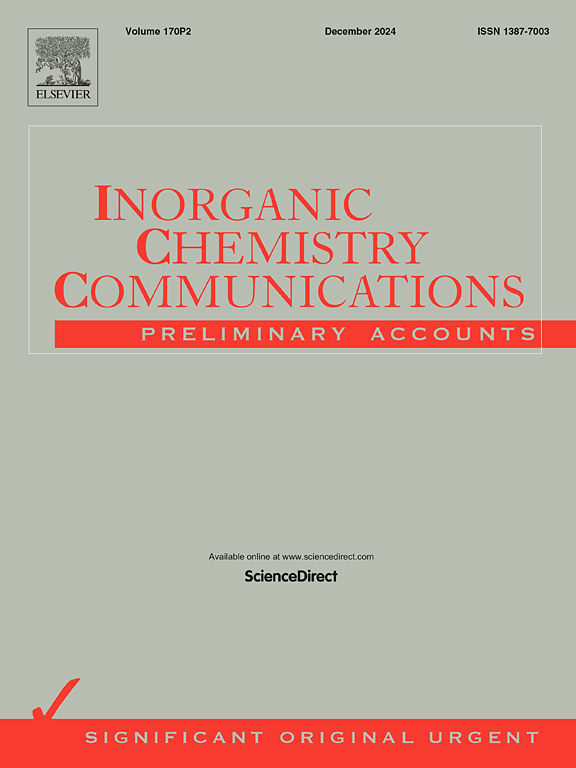便捷合成 CQD/g-C3N4 作为高效无金属光催化剂降解胭脂红和靛蓝染料
IF 4.4
3区 化学
Q1 CHEMISTRY, INORGANIC & NUCLEAR
引用次数: 0
摘要
水生态系统中广泛存在的染料污染严重危害着生物的健康。为了有效清除水体中的染料污染物,光催化被认为是一种有效、能耗低、成本低的消毒技术。作为传统金属催化剂的替代品,不含金属的异相光催化剂更具可持续性,对环境也更友好。在此,我们报告了掺杂碳量子点(CQD)的氮化石墨碳(GCN)的简单水热化学制备方法。我们利用 XRD、SEM、FE-SEM、HR-TEM、EDX、FT-IR、BET 分析表面积、光致发光、紫外-可见光谱、ZETA 电位等分析仪器对制备的掺杂碳量子点的氮化石墨(CDCN)进行了表征。降解研究表明,与纯 GCN 相比,CDCN 催化剂的降解率最高。在 60 分钟内,它对靛蓝胭脂红(IC)的降解率为 96%,对胭脂红染料(CM)的分解率为 93%。CDCN 催化剂之所以能提高光催化降解效率,其显著的 e-/h+ 分离、增大的表面积和诱导电荷熊的高氧化还原电位能力可能都是原因所在。通过研究和改变许多变量,光催化过程的效率得到了优化。其中包括染料浓度、催化剂浓度和 pH 溶液的变化。在连续进行三次光催化过程后,纳米复合材料表现出了极佳的稳定性。动力学分析结果表明,靛蓝(IC)和胭脂红(CM)染料的光催化分解遵循伪一阶动力学。为了获得更好的光降解性能,有人提出了一种潜在的光催化方法,即采用多对电子-空穴受体清除剂。根据带隙的位置和表征结果,还提出了可行的电荷载体机制途径。本文章由计算机程序翻译,如有差异,请以英文原文为准。

Facile synthesis of CQD/g-C3N4 as a highly effective metal-free photocatalyst for the degradation of carmoisine and indigo carmine dye
The development of extensive dye pollution in the water ecosystem seriously endangers the health of the living organism. For effectively eradicating dye contaminants from water bodies, photocatalysis is considered an effective, energy-consumption, inexpensive disinfection technique. As an alternative to conventional metal-based catalysts, heterogeneous metal-free photocatalysts are more sustainable and kinder to the environment. Here, we reported the simple hydrothermal chemical production of Carbon Quantum dots (CQD)-doped graphitic carbon nitride (GCN). Analytical instruments such as XRD, SEM, FE-SEM, HR-TEM, EDX, FT-IR, the surface area of BET analysis, photoluminescence, and UV–vis spectroscopy, zeta potential were used to characterize the as-prepared CQD doped GCN (CDCN). The degradation studies reveal that the CDCN catalyst displays the highest rate of degradation performance than pure GCN. Within 60 min, it shows 96 % degradation toward indigo Carmine (IC) and 93 % decomposition towards carmoisine dye (CM). Significant e−/h+ separation, an increased surface area, and a high redox potential capacity to induce charge bears may all contribute to the CDCN catalyst’s enhanced photocatalytic degradation efficiency. The efficiency of the photocatalytic process was optimized by studying and altering many variables. These include Dye concentration, catalyst concentration, and variation of the pH solution were some of these. The nanocomposite exhibited excellent stability after three successive runs of the photocatalytic procedure. According to the kinetics analysis results indicate that the photocatalytic decomposition of Indigo Carmine (IC) and carmoisine (CM) dye follows pseudo-first-order kinetics. For better photodegradation performance, a potential photocatalytic method employing several pairs of electron-hole acceptor scavengers has been put forth. Based on the positions of the band gap and the result of the characterization, a feasible mechanism pathway for charge carriers was also presented.
求助全文
通过发布文献求助,成功后即可免费获取论文全文。
去求助
来源期刊

Inorganic Chemistry Communications
化学-无机化学与核化学
CiteScore
5.50
自引率
7.90%
发文量
1013
审稿时长
53 days
期刊介绍:
Launched in January 1998, Inorganic Chemistry Communications is an international journal dedicated to the rapid publication of short communications in the major areas of inorganic, organometallic and supramolecular chemistry. Topics include synthetic and reaction chemistry, kinetics and mechanisms of reactions, bioinorganic chemistry, photochemistry and the use of metal and organometallic compounds in stoichiometric and catalytic synthesis or organic compounds.
 求助内容:
求助内容: 应助结果提醒方式:
应助结果提醒方式:


